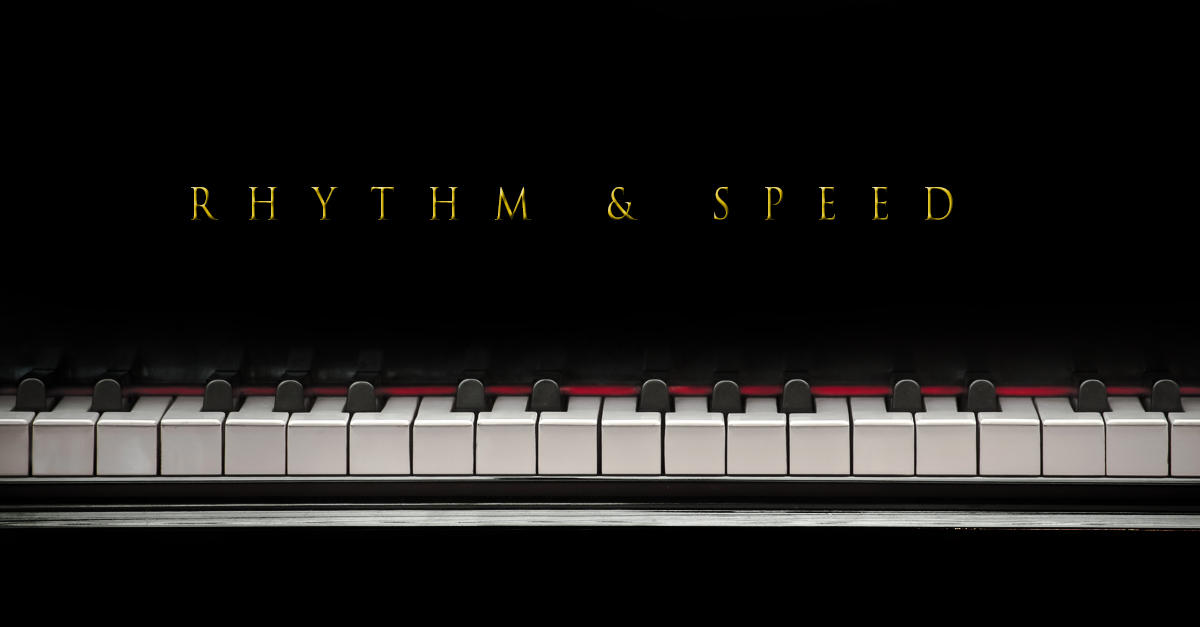
By Carl Valle
For years we have heard the phrase relax and win, where relaxing is heralded as the secret to speed, to winning. Relaxation is essential. But what facilitates relaxation when sprinting at speed? The answer may be rhythm, a lesser-known quality that may be more important than we think for speed. In this article, we will explore what rhythm is and what we can do in training to improve it.
Training footage of some of the fastest athletes in the world shows important commonalities among the top performers, including rhythm. Rhythm—in this instance the ability to maintain a pattern of athletic movement—is one of the most underrated motor skills a coach can impart. Many coaches focus on movement variability and other areas to help with the acquisition of coordination. But if we look at the training footage and who is on the podium and in the record books, we get a sense of the strong influence of rhythm in the training of world champions. This article will share observations and data to define rhythm and to offer an international perspective on what athletes are doing to develop and use rhythm to win.
“Keeping a steady time means that you are on the beat … and that is rhythm.”
—Brooks Johnson, Olympic Track & Field Coach
The dictionary definitions that we commonly rely on oftentimes do not apply to the concept that we’d hoped to define. And so it is with rhythm. In track and field, speed is the most important quality, even in the distance events. Speed can be easily measured, or defined, but the factors that contribute to speed, such as rhythm, are more elusive. Yet it is precisely because the presence or absence of these factors explains why some athletes are winning and some are missing the podium that we need to come up with a definition. The following is a good, though not perfect, working definition of rhythm that provides a foundation for coaches who are trying to add it to complement their otherwise fundamentally sound training: Rhythm is a strong, regular, repeated pattern of movement or sound.
The most obvious question is how does an athlete perform activities with rhythm and, more importantly, how does this make the athlete faster? It seems obvious at first glance. Many of us have tried to achieve rhythm in the sprints, hurdles, and jumps but have been humbled in our attempts by not knowing how easily such a pure quality is sabotaged by fatigue and poor training design.
Breaking Down the Beat
When most research on running speed is done, it involves an attempt to break down stride length (distance between each step) and stride frequency (the rate of steps per second) to organize speed into more detail. One problem is that sprinting is never constant; every running event has fatigue and, sometimes, a pacing strategy, in the 200 m and 400 m, influencing changes in the aforementioned qualities.
Athletes each have their own racing strategy because each athlete is unique, but what we can conclude is that velocity and its decay can be a simple summary of the challenge of the sprinting events. Breaking down the sprints into who achieves the least amount of time from point A to point B is perhaps an oversimplification but nevertheless provides a true measure.
Two crude factors exist with improving speed, that of finding a better way to increase output or applied power through training (development) and that of managing the energy resources allotted (pacing). When an athlete accelerates, the rhythm of stride frequency and the stride length increase with each step. Eventually, acceleration hits a speed barrier and culminates in a constant rhythm for a very brief time of what can be considered max velocity. A short time after max velocity is hit, fatigue surfaces and deceleration reduces stride length and frequency significantly. Athletes whose speed decays less finish faster, provided all of the athletes in the field have similar or equal acceleration and maximal speed levels.
These three phases—of acceleration, max speed, and deceleration—can be observed in all sprint events, from the 100 m through the 400 m. The shortest event, the 50 m, is a rare distance during indoor competition and is mainly acceleration at the elite level. But any outdoor event encompasses the above three phases.
By the smallest scale, each step taken is a unique pattern and rhythm in itself that sees the muscle groups firing in harmony and in a particular sequence of contractions. The slightest misfire can break the smooth beat between right and left strides, and the athlete can tighten up or even pull a muscle as a result.
Our bodies do a wonderful job of running on “autopilot” because of the wonderful power of the central nervous system. Sometimes, however, we overthink (paralysis by analysis) or make a tactical mistake and change the rhythm at the wrong time or too abruptly. We see this all the time when athletes are side by side and forced to decide whether to trust their race strategy or be lured into a duel that could backfire on the more macho or overly emotional sprinter. As the saying goes, the best move in the sprints is not a move, it’s best to stick to the strategy and let the nerves of racing add “volume” to the execution.
Since the rise to sprint dominance of the Jamaicans in the mid-2000s, a renaissance of interest has occurred in relaxation techniques through cues or workouts from Bud Winter and earlier legendary coaches. Sprint coaches have known for years that relaxation prevents tightening up and running slower, but to expect a conscious effort at relaxing to result from a coach’s yelling about it from afar is hardly a proper way to influence or manage tension.
Some coaches nudge athletes with reminders about relaxation during practice. But there are many good workouts that help to produce relaxation in athlete’s not blessed with a natural proclivity for being relaxed. Travel to Jamaica and other of the world’s major sprinting hubs over the last 15 years to observe practices has revealed what the fastest men and women do to develop relaxation. Witnessing several world record holders and medalists from different countries and coaches has led to the following four most conspicuous revelations about why some programs are able to develop speed through relaxed and rhythmic running.
Smooth. Good sprinting is obvious where the necessary changes in rhythm are barely perceived, like the blending of color to an oil painting or a fade to black in an Oscar-winning movie. Some of the most successful coaches, such as John Smith, have used very powerful analogies, including “don’t disturb the passengers during takeoff” (acceleration) to help athletes absorb the subtle nuances of efficient sprinting.
Consistent. Consistent means that the athlete is like clockwork with his or her timing of output. This can be developed by nearly any means, such as ensuring that each speed repetition is run at the same speed or having each split run evenly during longer reps. Consistency creates stable ground for the coach and athlete to work from, since a moving target is harder to hit than a firmly rooted one. A stable platform of consistent practice times increases the ability to grow from knowing what is learned and what cannot be repeated when it counts.
Extensive. Similar to consistent, extensiveness means an athlete can hold rhythm over a long period. Although technically a perfect or mathematically same tempo never happens, the better athletes have the biochemical (conditioning) ability to go faster longer than their less-endowed peers. Endurance is a factor in the ability to hold rhythm, but well-executed runs are a combination of specific conditioning and a trance-like concentration that result only from a great season of training. A simple way to differentiate consistent and extensive abilities is to think about replicating output versus holding tempo during the pain of fatigue, a period when the mind is seducing you to retreat to a comfort zone (homeostasis).
Balanced. The concept of balance to produce rhythm focuses on program design over a career or season rather than on a particular sprint training technique. The best programs evenly weight all factors that contribute to success. An example of this includes programs that produce sprinters who each have great 100 and 200 abilities, indicating that they are more than good starters, in that they have good 200 m endurance and great top speed to run the short sprint.
An example of poorly balanced programs is frequently seen in 400 m runners who have great fitness from base training but who are unable to race competitively during relays or early-season meets for their lack of speed. Other examples include high school programs whose athletes lack the training and competition experience to hold sprint form during a race. For lack of exposure to race-simulating forces and velocities, this usually results in athletes who surge and decelerate multiple times in races as they try to hold technique.
These four principles are the tip of the iceberg, but what makes them useful is that they all are measureable with split timing. Years of pondering after visiting elite coaches and two years of experimentation have led to understanding what can be done when practices are timed. Some coaches may have the ability to gauge with the naked eye, but genuine precision is hard to measure this way. Electronic timing audits our programs for the highest level of accuracy.
Now that we have definitions for rhythm and its components, let’s look at the most common workouts and see how simple analysis can enhance our training sessions.
Measuring Smoothness
The gradual but aggressive acceleration of sprinting as well as the steady decay of velocity can be timed by doing splits ranging from 10 m in the 60 m or 100 m to 50 m in 400 m workouts. Rating the data is easy; you simply look for no dead spots or spikes in the data.
Common errors include blasting out an amazing 10–20 m from the blocks with so much effort that the transition is too abrupt and the drop in velocity rapid. Sometimes, float sprints of alternating surges are strangely good options in teaching excellent transition and in exposing athletes to contrasting training modalities, but there is a full spectrum of additional rhythmic options that also can calibrate smooth execution by athletes.
Measuring Consistency
One of the best examples of measuring consistency is found in the timing of the world record performance of Aries Merrit in the hurdles, where no split has any statistical outlier and every hurdle cycle is blended from hurdle one to hurdle ten. Consistency isn’t always an ideal rhythm; it is the ability to repeat a rhythm over and over.
Repetition is still and perhaps more vital now than in the past. Practice variability for skill acquisition as suggested by many people is great in theory. Unfortunately, most coaches see great skills from athletes and just want their athletes to replicate performances over and over at any given time or place.
Accurately measuring athletes’ temporal deviation from speed per given repetition or race, however, is more helpful. It offers an advanced statistical breakdown beyond mean, median, and mode. Beyond the coefficient of variation, not much else is needed. The smaller the variation in times the better, as this shows that athletes are trying to be consistent and are acquiring the familiarity with speed that allows relaxation to bloom nicely.
Measuring Extensiveness
Holding an even pace especially at a high velocity and over a long period of time has many maximal speed benefits neurologically. The true scientific rationale is unclear, but the phenomenon of speed through endurance is not about the ability to endure fatigue. It’s more about the ability to prevent the antagonist muscle groups from locking up at the wrong time.
Relaxation is about shutting down or quickly lowering the switch times from near maximal contraction to a period of relative silence. Electromyography, or the study of the activation of muscle groups during movement, is a helpful guide in seeing how fatigue, either from a lack of conditioning or from pacing too fast too early, hurts rhythm.
One reason for the popularity of 150 m as a speed endurance distance is its requirement of an even distribution of work, not just among runs but also within splits. Two of the most common frustrations of coaches are an athlete’s not finishing strong and “freelancing” the pace by holding too much for the end after being overly cautious early on. Giving splits encourages a good rhythm by the athlete and allows the athlete’s body to subconsciously get into autopilot by removing the conscious interference and letting the body act almost reflexively.
Measuring Balance
It can be argued that achieving a balance of rhythm is a summary of the other three qualities. In fact, it’s more about a proper allocation of workouts and meets. A fair perspective is that balance ranges from the race splits being properly weighted based on an efficient use of energy to a proper calendar of races to enable success. Several philosophies and approaches are effective, and each circumstance is unique. So it’s up to coach and athlete to determine what has worked by reviewing at season’s end whether the workout and competition calendar was properly distributed for ultimate performance.
None of the suggestions above are rocket science or new. The point is to remind coaches that although we may already be striving for rhythm to achieve relaxation and thus maximal speed and success, we need to be more purposeful and conscious in planning for it. Some coaches are idiot savants and have no clue how brilliant they are. Many things simply come naturally to them. More of us, however, are not brilliant or intuitive. We are merely average coaches wanting to get above-average results by seeing what has been successful historically in speed training and by doing a good job of implementing what we know works.
Please share this article so others may benefit.
[mashshare]



What you are talking about is the basics of music. If you want an athlete to learn rhythm, teach him to play a musical instrument or sing in a group. Teach him/her to dance with a partner. When they learn to keep in step with a partner or in sync with others playing or singing simple music. they will have this concept down.
Dancer, singer, piano player, played in orchestra, and band. minor in music….any of these activities will develop the rhythm you are looking for…….
Just like how Bruce Lee was a better fighter because he knew how to dance.